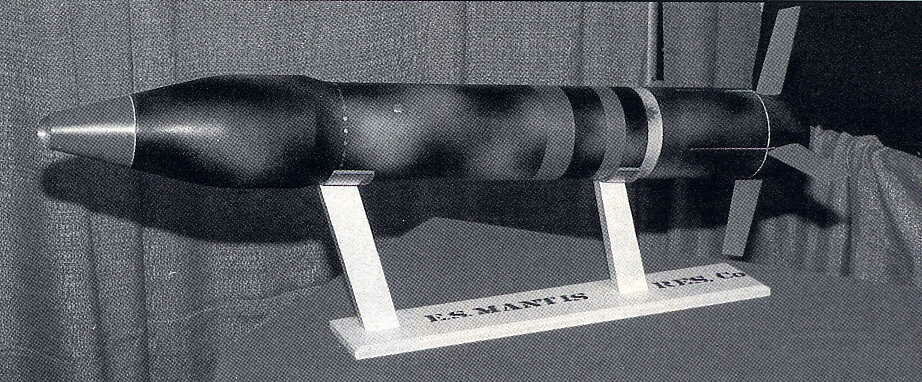You are using an out of date browser. It may not display this or other websites correctly.
You should upgrade or use an alternative browser.
You should upgrade or use an alternative browser.
ATM-05 Black Widow
- Thread starter xena
- Start date
This is the same picture I have. But not more. I know that it was a development project and that it has an EO element on the tip and that the electronics are in the center section of the missile. There was an article in one of the defence magazines in the '80ies, I don't know IDR or Interavia or something else. It' been too long. I hope someone has some more information about it.
From the looks of it, an outfit incorporated in April 1977 under the name of E.S. Mantis Research was based in North Vancouver, British Columbia. Its founder was one Elmo Sitnam. It allegedly had 20 or so employees around 1983-85.
Sitnam was seemingly born in Trinidad around 1919. He moved to England and seemingly trained as a civil engineer. Sitnam moved to Canada around 1963. He and his family lived in Montreal (Quebec) and Sarnia (Ontario) before a final move to Vancouver, around 1973.
In the late 80s and / or early 90s, E.S. Mantis Research cooperated with a provincial organisation, British Columbia Research Corporation (BCRC) of Vancouver, to develop an avalanche control projectile it had designed. That project went nowhere as a result of the explosion of a projectile in a snow gun, in April 1991, at Whistler Mountain, which killed a ski patroller and slightly injured two others.
A coroner's inquiry concluded in January 1992 that the gun was not to blame, a faulty projectile was.
A 1991 U.S. patent for that projectile can be found at https://patents.google.com/patent/CA2015773A1/en?inventor=Elmo+Sitnam
In the course of the inquiry, it became known that Sitnam, then aged 72, was not a PhD in Aeronautical engineering with a great deal of experience in explosives and rocketry, nonexistent qualifications he had used to obtain the assistance of various people and organisations, including the National Research Council of Canada, which provided him with funding. Sitnam admitted he did not have a PhD but claimed that he had two diplomas from British engineering institutes, including an outfit called BIET, possibly the British Institute of Engineering Technology.
In any event, the coroner's report pointed out that "Sitnam's knowledge of explosives was lacking and he conducted some extremely dangerous modifications to the charges and fuses. Many of the safety features found on a standard projectile had been removed or altered on the prototype. The handling, storage and transportations of projectiles were haphazard at best"
It has been suggested that, given that Canada's Charter of Rights and Freedom protected him from self-incrimination at the inquiry, Sitnam walked away scot-free, even though the inquiry put the blame for the explosion very much on him.
Sitnam appeared to be an inventor with a solar collector (U.S. patent dated 1981) and a pair of biodegradable diapers (1993 and 1994) under his belt. In 1992, he was working on an "aerodynamic grenade" and "something called a Black Widow anti-matter tank."
Sitnam was seemingly born in Trinidad around 1919. He moved to England and seemingly trained as a civil engineer. Sitnam moved to Canada around 1963. He and his family lived in Montreal (Quebec) and Sarnia (Ontario) before a final move to Vancouver, around 1973.
In the late 80s and / or early 90s, E.S. Mantis Research cooperated with a provincial organisation, British Columbia Research Corporation (BCRC) of Vancouver, to develop an avalanche control projectile it had designed. That project went nowhere as a result of the explosion of a projectile in a snow gun, in April 1991, at Whistler Mountain, which killed a ski patroller and slightly injured two others.
A coroner's inquiry concluded in January 1992 that the gun was not to blame, a faulty projectile was.
A 1991 U.S. patent for that projectile can be found at https://patents.google.com/patent/CA2015773A1/en?inventor=Elmo+Sitnam
In the course of the inquiry, it became known that Sitnam, then aged 72, was not a PhD in Aeronautical engineering with a great deal of experience in explosives and rocketry, nonexistent qualifications he had used to obtain the assistance of various people and organisations, including the National Research Council of Canada, which provided him with funding. Sitnam admitted he did not have a PhD but claimed that he had two diplomas from British engineering institutes, including an outfit called BIET, possibly the British Institute of Engineering Technology.
In any event, the coroner's report pointed out that "Sitnam's knowledge of explosives was lacking and he conducted some extremely dangerous modifications to the charges and fuses. Many of the safety features found on a standard projectile had been removed or altered on the prototype. The handling, storage and transportations of projectiles were haphazard at best"
It has been suggested that, given that Canada's Charter of Rights and Freedom protected him from self-incrimination at the inquiry, Sitnam walked away scot-free, even though the inquiry put the blame for the explosion very much on him.
Sitnam appeared to be an inventor with a solar collector (U.S. patent dated 1981) and a pair of biodegradable diapers (1993 and 1994) under his belt. In 1992, he was working on an "aerodynamic grenade" and "something called a Black Widow anti-matter tank."
- Joined
- 9 October 2009
- Messages
- 20,411
- Reaction score
- 11,143
Possible. Then again he might have had people who knew what they were doing working for him on that project.
Similar threads
-
Details wanted on the Mk.42 Torpedo (United States)
- Started by Graham1973
- Replies: 0
-
ARDC TP-900 three-turbine helicopter project
- Started by hesham
- Replies: 3
-
German Special Air-Air Anti-Bomber Weapons
- Started by moin1900
- Replies: 18
-
-
JPL's Rocket Air Foil Tester (RAFT) + Northrop sled at Muroc
- Started by Stargazer
- Replies: 0

